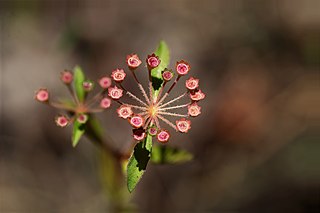
The Francoaceae are a small family of flowering plants in the order Geraniales, including the genera Francoa, commonly known as bridal wreaths. The Francoaceae are recognized as a family under various classification schemes. Under the 2009 APG III system the Francoaceae were included within the Melianthaceae. In the 2016 APG IV system the Francoaceae are again recognized as a family, with Melianthaceae included in the circumscription of Francoaceae.

Christian Horace Benedict Alfred Moquin-Tandon was a French naturalist and doctor.

Agonis is a genus of flowering plants in the plant family Myrtaceae. All are endemic to Western Australia, growing near the coast in the south west. Plants in the genus Agonis are shrubs or trees with bisexual flowers arranged in heads in leaf axils with 5 sepals and usually 5 white petals, each with 15 to 30 stamens arranged opposite the sepals, and the fruit a woody capsule.
The hybrid elm cultivar Ulmus × hollandica 'Dauvessei', one of a number of cultivars arising from the crossing of the Wych Elm U. glabra with a variety of Field Elm U. minor, is a very rare cultivar said to have originated at the D. Dauvesse nursery in Orléans, France before 1877.
The elm cultivar Ulmus × hollandica 'Blandford' was listed by the Urban Forestry Administration (UFA) of the District Department of Transportation in Washington, D.C., as one of its 'street trees' in 2008. As the UFA has no further documentation to support it, the entry may be spurious, but it is most likely the tree is the wych elm cultivar Ulmus glabra 'Superba', known in the UK as the 'Blandford Elm' and introduced to the US in the early 20th century, or possibly the hybrid cultivar Ulmus × hollandica 'Superba' present in some American collections, including Garfield Park, Washington, D.C., in the mid-20th century.
Amphiglossa is a genus of flowering plants in the family Asteraceae, described as a genus in 1838. It includes ten species native to Namibia and the Cape Provinces of South Africa.
Oedera flavicoma is a species of flowering plant in the family Asteraceae. It is native to Cape Province in South Africa.
Arrowsmithia is a genus of flowering plants in the family Asteraceae.

Corethrogyne is a monotypic genus of flowering plant in the family Asteraceae. Its only species is Corethrogyne filaginifolia, known by the common names common sandaster and California aster.

Duhaldea is a genus of Asian flowering plants in the daisy family.

Leptocarpha is a monotypic genus of flowering plants in the family Asteraceae. It is endemic to central Chile.
Marasmodes is a genus of South African shrubs in the chamomile tribe within the daisy family. It is endemic to the Cape Provinces of South Africa.
Moquinia is a genus of flowering plants in the tribe Moquinieae within the family Asteraceae.
Syncephalum is a genus of flowering plants in the pussy's-toes tribe within the family Asteraceae.
Blanchetia is a genus of flowering plants in the family Asteraceae, It is endemic to Brazil.

Chresta is a genus of South American flowering plants in the family Asteraceae.

Chronopappus bifrons is a species of flowering plant in the family Asteraceae, native to southeast Brazil. It was first described by Christiaan Hendrik Persoon in 1807 as Serratula bifrons.

Pomax is a genus of flowering plants in the coffee family, Rubiaceae. Pomax umbellata, found in Australia, is the sole species of the genus. The genus was created in 1830, by the Swiss taxonomist Augustin Pyramus de Candolle, and published in his Prodromus Systematis Naturalis Regni Vegetabilis. Pomax umbellata was first described as Opercularia umbellata by Joseph Gaertner in 1788. but was transferred to the genus, Pomax by Daniel Solander in 1834.

Curio is a genus of flowering plant in the family Asteraceae. Plants in the genus are evergreen succulents with long, striated leaves and discoid flower heads lacking ray florets.

Podolepis canescens is a herb in the Asteraceae family, which is found in South Australia, the Northern Territory, New South Wales and Victoria. PlantNet also states that it is found in Western Australia, but FloraBase states that the name is misapplied in Western Australia, based on Jeanes (2015).











